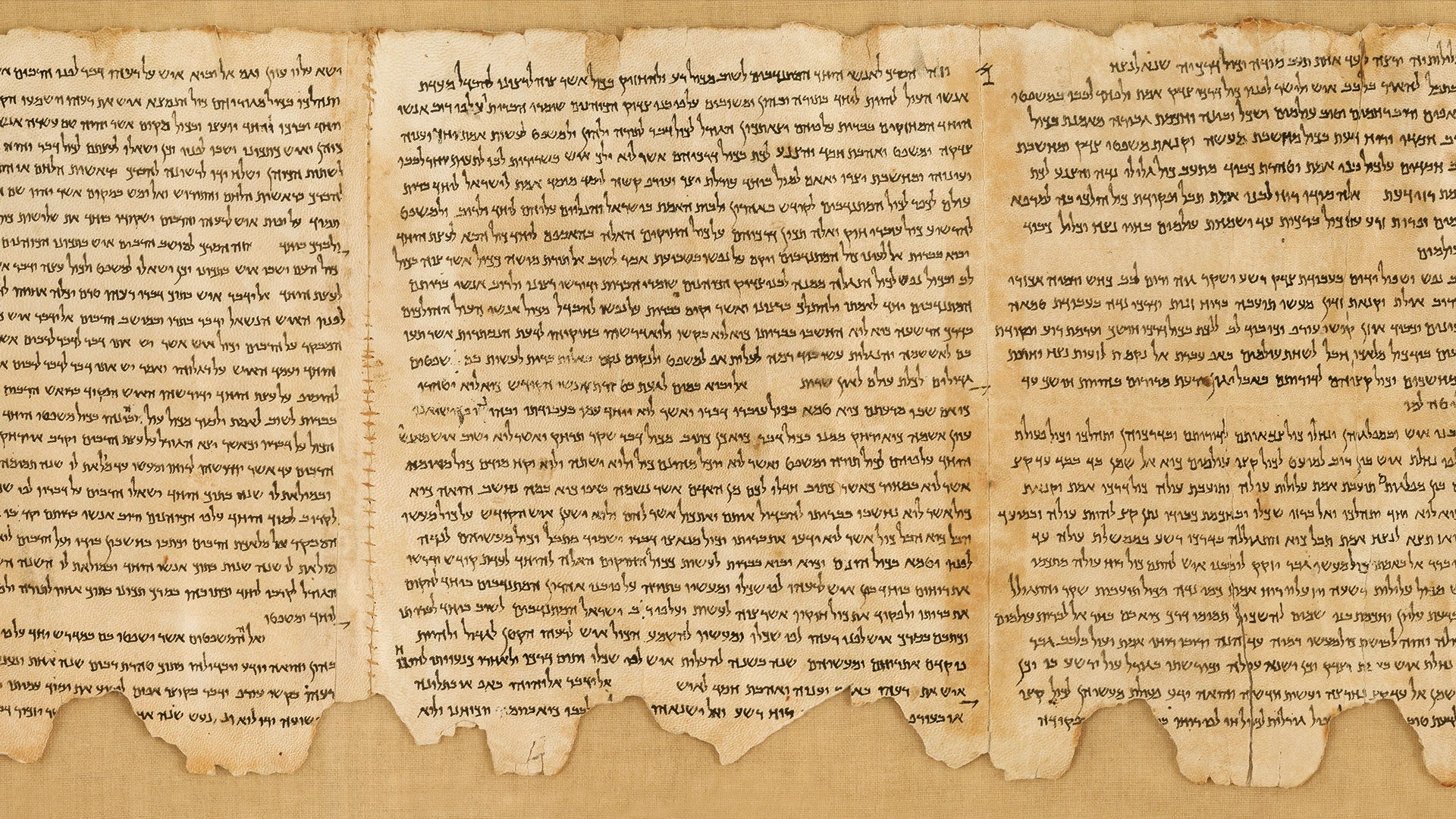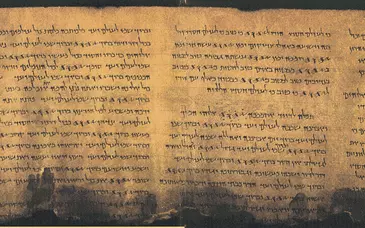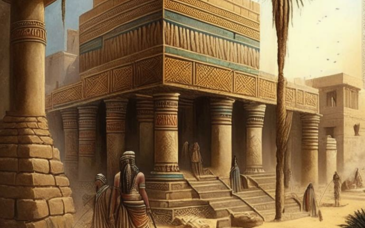1. The Dead Sea Scrolls were discovered between 1947-1956 in 11 caves (5 by Beduin; 6 by archaeologists) on the upper northwest shore of the Dead Sea. The area is 13 miles east of Jerusalem, and is -1300 ft. below sea level (Jerusalem is +2400 ft. above sea level).
2. Near the caves are the ancient ruins of Qumran, which was excavated in the early 1950's and appears to be connected with the Scrolls.
3. The Scrolls appear to be the library of a Jewish sect which was hidden away in caves around the outbreak of the Jewish-Roman War (66 C.E.). Archaeological evidence indicates the settlement had been inhabited since about 150 B.C.E.
4. The sect has most often been identified with the Essenes, who are mentioned by the historian Josephus and are in a few other sources, but are not in the N.T. They were an intensely messianic, apocalyptic, baptist, wilderness, new covenant group, led by a priest they called the "Teacher of Righteousness" who was opposed and possibly killed by the establishment priesthood in Jerusalem.
5) The Scrolls so far discovered represent a library of about 800 volumes/scrolls, many of which are represented only by fragments. For example, cave 4 contained 520 texts in 15,000 fragments.
6) This library contains copies of the Scriptures (Isaiah Scroll), copies of other non-canonical books known to us (Enoch), and holy writings which the group itself produced (rules of faith, commentaries on Scriptures, and many other fascinating works otherwise unknown to us). In Cave 3, there was one Copper Scroll found, which contains a list of 64 hiding places where gold, silver, sacred objects, and other scrolls were hidden.
7) The major intact texts, from Caves 1 & 11, came into Israeli hands and were published by the late 1950's--they are now in the Shrine of the Book museum in Jerusalem.
8) The bulk of the scrolls were in Jordanian control and were placed with a team of Christian (mostly Catholic--no Jewish) scholars who over the next four decades published eight volumes of material. The team was left intact by the Israelis after the Six Day War (1967). The publication schedule was constantly delayed and many outsiders found the official team to be arrogant and uunwielding. The team was expanded in the 1980's and was much more broadly based, finally including Jewish scholars and a more open approach to sharing materials.
9) As much as 40% of the Scrolls, mostly fragments from Cave 4, remained unpublished and unreleased (photos), until pressure mounted in the 1980's. A breakthrough occurred in the Fall, 1991: the photos were published by the Biblical Archaeological Society in a non-official edition; a computer reconstruction, based on a concordance, was announced; the Huntington library pledged to open their microfilm files of all the scroll photographs.
10) The Scrolls are of great interest to both Jews and Christians. They represent a non-rabbinic form of Judaism, and also contain many important parallels to the Jesus movement. Final interpretations of these materials, with the newly released Scrolls fully factored in, remains open.
11) Scrolls related to those found in the caves around Qumran were also found at Masada, the Herodian fortress taken over by Jewish Zealots after the fall of Jerusalem in 70 C.E. and finally taken by the Romans in 73 C.E.
12) An ostracon (inscribed pottery sherd) containing a 16 lineletter written in 68 C.E. by someone giving their property over to the community was discovered at the site of Qumran in January, 1996.
Basic Facts Regarding the Dead Sea Scroll

You Might Also Like:
The present work was evidently intended to govern a ritual of baptism or ablutions. A sectarian text by virtue of its mention of the Yachad, this liturgy may have operated during the ritual washings that are discussed in the Charter (see text 5, 3:4-9; 4:21; 5:13b-14). The Liturgy's distinctive form...
Read More
1Q29
F.1
(...) (...) the stone, just as the LORD commanded ....) and your Urim. And it (the cloud?) shall come forth with him, with the tongues of fire. The left-hand stone which is on its left side shall be uncovered before the whole congregation until the priest finishes speaking and after the clo...
Read More
Col.2
(...) And concerning what Scripture says, "In this year of Jubilee you shall return, everyone f you, to your property" (Lev. 25;13) And what is also written; "And this is the manner of the remission; every creditor shall remit the claim that is held against a neighbor, not exacting it of a nei...
Read More
F.1 Col.2
Please consider this, you who are wise: If a man has a fine tree, which grows high, all the way to heaven (...) (...) of the soil, and it produces succulent fruit every year with the autumn rains and the spring rains, (...) and in thirst, will he not (...) and guard it (...) to multiply th...
Read More
The scrolls and scroll fragments recovered in the Qumran environs represent a voluminous body of Jewish documents, a veritable "library", dating from the third century B.C.E. to 68 C.E. Unquestionably, the "library," which is the greatest manuscript find of the twentieth century, demonstrates the r...
Read More

Read More
Tehillim
Psalms (Tehillim) 11QPs
Parchment
Copied ca. 30 - 50 C.E.
Height 18.5 cm (7 1/4 in.), length 86 cm (33 3/4 in.)
Courtesy of the Israel Antiquties Authority
This impressive scroll is a collection of psalms and hymns, comprising parts of forty-one biblical psalms (chiefly form chapters 101-5...
Read More
Tefillin
Fragment A: height 17.7 cm (7 in.)
length 3 cm (1 3/16 in.)
Fragment B: height 3.8 cm (1 1/2 in.)
length 2.8 cm (1 1/8 in.)
Mur 4 Phyl
Parchment
Copied first century-early second century C.E.
Courtesy of the Israel Antiquities Authority (3)
The command "And thou shalt bind them for a si...
Read More
Serekh ha-Yahad
Height 8.8 cm (3 7/16 in.), length 21.5 cm (8 7/16 in.)
4Q258 (Sd)
Parchment
Copied late first century B.C.E.Äearly first century C.E.
Courtesy of the Israel Antiquities Authority (7)
Originally known as The Manual of Discipline, the Community Rule contains a set of regulations orde...
Read More
Mishmarot
Height 13.4 cm (5 1/4 in.), length 21.1 cm (8 1/4 in.)
4Q321 (Mishmarot Ba)
Parchment
Copied ca. 50-25 B.C.E.
Courtesy of the Israel Antiquities Authority (10)
A significant feature of the community was its calendar, which was based on a solar system of 364 days, unlike the common Jewish ...
Read More
Miqsat Ma`ase ha-Torah
Fragment A: height 8 cm (3 1/8 in.)
length 12.9 cm (5 in.)
Fragment B: height 4.3 cm (1 11/16 in.)
length 7 cm (2 3/4 in.)
Fragment C: height 9.1 cm (3 9/16 in.)
length 17.4 cm (6 7/8in.)
4Q396(MMTc) Parchment Copied late first century B.C.E.-early first century C.E. Co...
Read More
Hanokh
Fragment A height 17.5 cm (6 7/8 in.), length 17.5 cm (6 7/8 in.)
Fragment B height 6.4 cm (2 1/2 in.), length 6.9 cm (2 11/16 in.)
4Q201(En ara)
Parchment
Copied ca. 200-150 B.C.E.
Courtesy of the Israel Antiquities Authority (11)
One of the most important apocryphic works of the Second Temp...
Read More
Pesher Hoshe`a
4Q166 (4QpHosa)
Parchment
Copied late first century B.C.E.
Height 17.5 cm (6 7/8 in.), length 16.8 cm (6 5/8 in.)
Courtesy of the Israel Antiquities Authority (6)
This text is a commentary, or "pesher," on the prophetic biblical verses from the book of Hosea (2:8-14). The verse pres...
Read More
Tefillah li-Shlomo shel Yonatan ha-Melekh
4Q448
Parchment
Copied between 103-76 B.C.E.
Height 17.8 cm (7 in.), length 9.5 cm (3 3/4 in.)
Courtesy of the Israel Antiquities Authority (2)
The King Jonathan mentioned in this text can be none other than Alexander Jannaeus, a monarch of the Hasmonean dy...
Read More
Va-Yikrah
11Q1(PaleoLev)
Parchment
Copied late second century - early first century B.C.E.
Height 10.9 cm (4 1/4 in.), length 100.2 cm (39 1/2 in.)
Courtesy of the Israel Antiquities Authority (4)
This scroll was discovered in 1956, when a group of Ta`amireh Bedouin happened on Cave 11, but it was...
Read More
Shirot `Olat ha-Shabbat
4Q403(ShirShabbd)
Parchment
Copied mid-first century B.C.E.
Height 18 cm (7 in.), length 19 cm (7 1/2 in.)
Courtesy of the Israel Antiquities Authority (9)
The Songs of the Sabbath Sacrifice, also known as the "Angelic Liturgy," is a liturgical work composed of thirteen sepa...
Read More
Brit Damesek
4Q271(Df)
Parchment
Copied late first century B.C.E.
Height 10.9 cm (4 1/4 in.), length 9.3 cm (3 5/8 in.)
Courtesy of the Israel Antiquities Authority (1)
The Damascus Document is a collection of rules and instructions reflecting the practices of a sectarian community. It includes tw...
Read More
Serekh ha-Milhamah4Q285 (SM)
Parchment
Copied early first century C.E.
Height 4 cm (1 1/2 in.), length 5 cm (2 in.)
Courtesy of the Israel Antiquities Authority (12)
This six-line fragment, commonly referred to as the "Pierced Messiah" text, is written in a Herodian script of the first half of the f...
Read More

Read More
The ancient cultures section features many of the world's ancient cultures/empires. Presented with each is a brief history, a glossary, myths, rulers, and more.
The Oriental Institute Museum is a showcase of the history, art and archaeology of the ancient Near East. An integral part of the Universit...
Read More